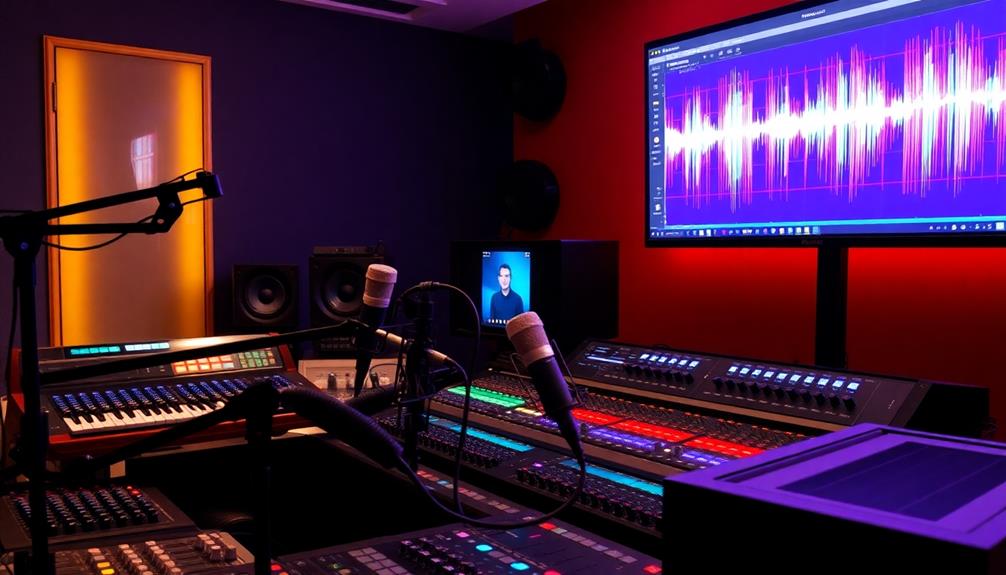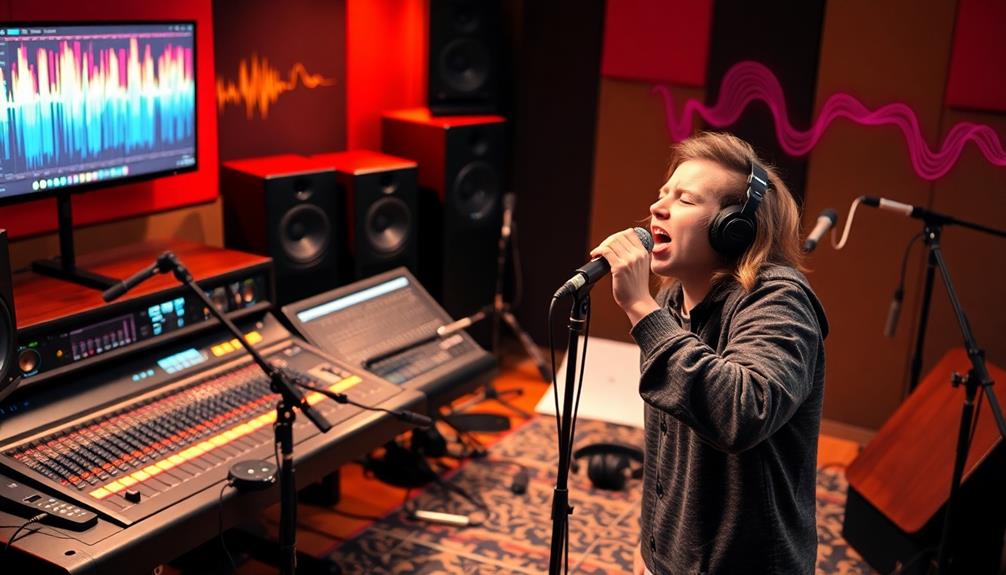If you want to bring your vocals to life, mastering vocal production is vital. You'll learn essential recording techniques like mic placement and room acoustics to capture the best sound. Effective editing strategies, such as timing alignment and pitch correction, can enhance your overall quality. You'll also explore processing methods that shape your vocals using EQ, compression, and creative effects. Finally, mastering advanced mixing techniques will help guarantee your vocals stand out. With all these skills, you can transform your tracks into professional-sounding masterpieces. Stick around, and you'll uncover tips that elevate your vocal production even further.
Key Takeaways
- Master recording techniques, including mic placement and room acoustics, to capture professional-quality vocals.
- Utilize effective vocal editing strategies like comping and pitch correction for polished performances.
- Apply processing techniques, such as compression and EQ, to enhance vocal clarity and presence.
- Implement advanced mixing techniques, including panning and automation, to create engaging vocal-centric tracks.
- Continuously improve your workflow by experimenting with new software and production methods for optimal results.
Importance of Vocal Production

Understanding the importance of vocal production is fundamental for anyone looking to create professional-sounding recordings. This process isn't just about hitting the right notes; it's about crafting an emotional journey that resonates with listeners. When you invest time in mixing vocals, you elevate the overall quality and impact of your music.
Vocal processing plays a significant role in this journey. Research shows that listeners can detect pitch corrections about 70% of the time, so you'll want to approach vocal processing with care to avoid sounding overly manipulated.
Each stage—recording, editing, and mixing—directly influences the final sound, making it essential to pay attention to detail throughout your editing sessions.
Effective vocal production techniques not only enhance professional vocals but also shape how your audience feels. A well-produced vocal can evoke strong emotional responses, important for genres ranging from pop to rock.
Remember to take regular breaks during the production process; this helps combat ear fatigue and leads to better decision-making when evaluating vocal quality. Prioritizing these aspects will set you on the path to creating unforgettable music.
Recording Techniques for Success

To achieve great vocal recordings, you need to focus on essential mic placement and room acoustics.
Position your microphone about 6-8 inches from your mouth and slightly off-axis to capture the best sound.
Additionally, consider DIY acoustic treatments to enhance your recording environment and minimize unwanted noise.
Essential Mic Placement Tips
Achieving the best vocal sound starts with the right microphone placement. Position your mic about 6-8 inches away from the vocalist, slightly off-axis at mouth level. This setup enhances sound clarity while minimizing plosive sounds that can disrupt your vocal recording.
In a world where technology is rapidly evolving, Apple's commitment to user data protection is a reminder of the importance of maintaining quality in every aspect of audio production. To further reduce plosives, use a pop filter; it's a small investment that greatly boosts the quality of your vocal takes.
It's also essential to take into account your recording environment. Aim for minimal background noise, as even subtle distractions can muddy your final product. If you can, treat your recording space acoustically to achieve a more professional sound.
Remember, every voice is unique, so don't hesitate to experiment with mic distance and angle. Small adjustments can yield different tonal qualities, allowing you to tailor the microphone placement to the specific voice and desired sound character.
Lastly, encourage vocal warm-ups before recording. This practice not only enhances the overall vocal performance but also helps in delivering better inflections and energy, vital for an emotional delivery.
Get these elements right, and you'll set the stage for outstanding vocal recordings!
DIY Acoustic Treatment Techniques
While proper mic placement lays the foundation for great vocal recordings, the acoustics of your recording space can make a significant difference in the final sound quality.
To enhance your recording quality, consider DIY acoustic treatment techniques that are budget-friendly and effective. Regular cleaning of your air purifiers can also improve air quality in your recording space, thereby reducing unwanted noise.
Start by creating acoustic panels: gather materials like wood for frames, fill them with rockwool, cover with fabric, and hang them strategically around your space. This will help absorb sound and reduce reflections.
In addition to panels, installing bass traps in the corners of your room is essential. These will control low-frequency sound waves, minimizing muddiness and enhancing clarity in your recordings.
If you're looking for cost-effective solutions, thick blankets and carpets can also work wonders, absorbing excess noise and improving the overall acoustics in less-than-ideal environments.
Effective Vocal Editing Strategies

When you're editing vocals, timing alignment and pitch correction are essential for achieving a polished sound.
You can use tools like Elastic Audio to sync your vocals perfectly with the music, while pitch correction software helps you fine-tune any inaccuracies.
Timing Alignment Techniques
Timing alignment is often essential in vocal editing, as it guarantees that your vocal phrases sync rhythmically with the instrumental tracks. This enhances the overall groove and feel of your song, making it more engaging for listeners.
Here are some effective techniques you can use:
- Vocal Comping: Compile the best takes from multiple recordings to improve timing cohesion. This creates a polished final product that feels tight and professional.
- Critical Listening: Pay attention to the rhythmic placement of your vocals. Identify areas that need adjustment to assure each phrase contributes to the track's momentum.
- Subtle Time Stretching: Use this technique to align vocal performances with the beat. It helps integrate them seamlessly into the mix while preserving their expressive character.
- Utilize Tools: Software like Pro Tools' Elastic Audio allows for precise timing adjustments without affecting pitch, keeping the natural quality of your vocal performance intact.
Pitch Correction Methods
Pitch correction is a significant aspect of vocal editing that can transform a good performance into a great one. By using industry-standard software like Auto-Tune or Melodyne, you can guarantee your vocals sound polished without losing their character.
Before diving in, though, it's important to identify the track's key and scale; this helps you apply pitch correction that aligns harmoniously with the underlying music.
To achieve the best results, focus on subtle pitch correction techniques. This approach allows you to preserve natural vibrato and emotional expression in the vocals, which are crucial for connecting with listeners.
You can also integrate timing adjustments within your audio workstation, utilizing tools like Pro Tools' Elastic Audio to make sure the corrected vocal phrases align rhythmically with the instrumental track.
Processing and Shaping Vocals

Effective vocal processing is essential for achieving a polished and professional sound in your mix. By focusing on the right techniques, you can greatly enhance your vocal production. Here are some key steps to reflect upon when processing and shaping vocals:
- High-Pass Filter: Start with a gentle high-pass filter around 80-100 Hz to eliminate unnecessary low frequencies. This helps prevent muddiness in your vocal sound.
- Compression: Use a compressor with low ratios (2:1 to 4:1) to maintain consistent vocal levels. This subtle dynamic control keeps the performance intact without squashing it.
- De-essing: Employ multi-band compressors targeting the 5-8 kHz range for effective de-essing. This reduces harsh sibilance, ensuring a smoother overall sound.
- Saturation and Effects: Add saturation to introduce harmonics and enhance richness.
For depth, apply creative effects like short plate reverb or subtle slapback delay, but do so judiciously to avoid muddiness.
Mixing Vocals Like a Pro

Mastering the art of mixing vocals is essential for creating a standout track that captivates listeners. To achieve a professional vocal mix, you need to balance levels with other instruments, ensuring your vocals are clear and prominent without overshadowing the entire track.
Start by applying EQ techniques to identify and adjust any problematic frequencies. This will enhance your vocal clarity, giving your performance a polished, professional sound.
Next, don't overlook the power of compression. By using compression specifically designed for vocals, you can smooth out the dynamic range, ensuring consistent volume levels and adding sustain for a fuller sound.
Consider incorporating panning techniques to create spatial effects that enhance your vocal's presence in the stereo field, making the mix feel more immersive.
Automation is key in your vocal mixing process, allowing you to make dynamic adjustments in volume, panning, and effects throughout the track. This keeps your listeners engaged and maintains their interest.
Advanced Mixing Techniques

Advanced mixing techniques can take your vocal production to the next level, guaranteeing your tracks stand out in a crowded soundscape. By employing these strategies, you'll enhance clarity and emotional impact in your vocal tracks.
For instance, understanding the importance of a well-structured music production workflow can greatly streamline your mixing process, allowing for more creative exploration music production workflow.
Here are four key techniques to take into account:
- Group/Buss Routing: Route your vocal tracks to a bus for collective EQ adjustments and to create space within the mix. This helps maintain a cohesive sound across all elements.
- Automation: Use automation to dynamically adjust vocal levels between verses and choruses. This technique creates contrast and keeps listeners engaged throughout your track.
- Dynamic Range Enhancement: Enhance the emotional depth of your vocals by implementing volume automation, allowing for subtle shifts that reflect the song's narrative.
- Vocal Doubling: Apply vocal doubling and delay effects to add thickness and presence to your vocals. This technique guarantees they stand out without overwhelming the mix.
Regularly review your mixes with spectrum analyzers to maintain vocal clarity and integration with other elements.
These advanced mixing techniques will elevate your productions and captivate your audience!
Finalizing Vocal-Centric Tracks

Finalizing vocal-centric tracks is an important step in the production process, guaranteeing that your vocals shine while maintaining harmony with the rest of the mix. Start by reviewing all your vocal takes for cohesiveness and clarity. It's vital that the vocals sit well within the mix without overpowering other elements. Once you’ve ensured cohesiveness, apply EQ and compression to shape the vocal tone and control dynamics, helping it blend seamlessly with the instrumental. Use professional track finishing techniques, such as automation for volume adjustments and adding subtle reverb or delay, to give the vocals depth and presence. These refinements ensure your track sounds polished and ready for release.
Using mastering tools can enhance vocal presence and polish, so be certain to test playback across various systems to achieve peak performance.
Consider stem mastering, which allows you to make separate adjustments to vocal groups, providing flexibility during this stage. This guarantees clarity and balance, making your final track sound natural.
Implement quality control measures by checking for phase coherence and utilizing spectrum analyzers to identify frequency imbalances.
Incorporating AI innovations, like modern pitch correction and voice cloning technology, can also streamline your workflow. However, remember to navigate the ethical considerations that come with these advancements in vocal production.
Continuous Improvement in Vocal Production

Continuous improvement in vocal production is essential for staying relevant in an ever-evolving industry.
To make sure you're on top of your game, consider these strategies for growth:
- Embrace New Software: Staying updated with the latest tools can enhance your workflow and help you adapt to shifts in vocal production technology.
- Experiment with Styles: Regularly trying out different techniques allows you to discover innovative approaches that can lead to improved creativity in your work.
- Analyze Successful Productions: Take time to dissect what works in other vocal productions. This analysis can reveal effective methods and strategies you can adapt to your projects.
- Engage in Workshops: Participating in workshops and online courses not only helps you learn new skills but also exposes you to fresh perspectives and insights from industry experts, fostering continuous skill development.
The Impact of AI in Production

The rise of AI in vocal production is transforming the way you approach music creation. AI innovations, like modern pitch correction tools and voice cloning technology, greatly enhance your workflow efficiency. By automating tedious tasks, these tools allow you to focus more on the creative aspects of music production.
Research shows that AI-driven vocal tuning can cut manual editing time by up to 50%, enabling you to achieve professional quality faster.
With AI algorithms analyzing vocal performances, you can receive suggestions for best pitch and timing adjustments. This helps maintain the natural character of a voice while elevating the overall sound. As a music producer, integrating these AI tools into your workflow has become increasingly common; a 2023 survey reveals that 67% of industry professionals utilize AI software to enhance their vocal tracks.
However, ethical considerations arise with the use of AI in vocal production. Concerns over the authenticity of AI-generated performances and the potential misuse of replicating artists' voices without consent highlight the need for responsible use.
Balancing innovation with ethics will be vital as you navigate this evolving landscape in music production.
Frequently Asked Questions
How Loud Should Vocals Be Before Mastering?
Vocals should peak around -6 dB to -3 dB before mastering. Aim for an average loudness of -12 LUFS to -6 LUFS, ensuring they blend well with the mix while preserving dynamic range.
How Do You Master Vocals Like a Pro?
To master vocals like a pro, review edits for clarity, enhance presence with mastering tools, and test mixes across systems. Separate vocal groups for adjustments, check for phase coherence, and address frequency imbalances. Stay updated on innovations.
How to Make Vocals Sound Fatter?
To make vocals sound fatter, layer multiple takes, apply gentle compression, boost low-mid frequencies, and use saturation plugins. Add reverb and delay sparingly for depth, ensuring clarity remains in your mix. Experiment and adjust!
Is Pro Tools the Best for Vocals?
If you're looking for the best software for vocals, Pro Tools stands out. Its powerful editing features, intuitive tools, and extensive plugin support help you achieve polished, professional-sounding vocal tracks for any genre.
Conclusion
In the world of music production, mastering vocal techniques is like sculpting a masterpiece from marble; it requires patience, precision, and creativity. By honing your recording, editing, and mixing skills, you'll bring your vocals to life, enchanting listeners with every note. Embrace the advancements in technology, and continually seek improvement in your craft. With dedication and the right techniques, you'll elevate your vocal productions, transforming them into unforgettable experiences for your audience. Keep pushing your boundaries!










